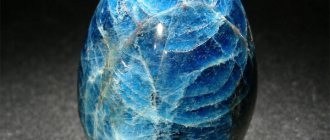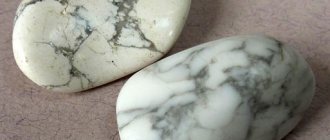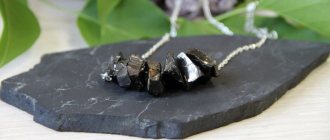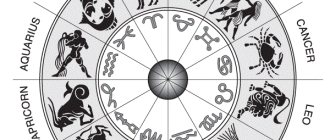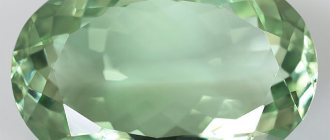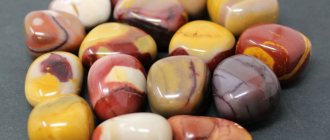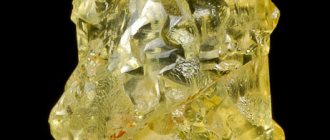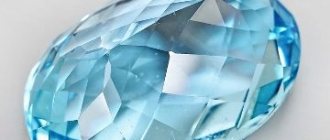History and legends of origin
Chiastolite stone is considered a variety of Andalusite and is characterized by the interesting inclusion of carbon in the form of a dark cross in the center of the gem. In nature it is found together with stones such as Corundum and Kyanite. It can also be found in igneous rocks such as granite.
Scientists identify several versions of the process of formation of an unusual type of stone. The most common is considered to be a change in the mineral under the influence of external factors.
As the crystals grow, they accumulate carbon impurities, and in certain places (corners). As inclusions increase, the growth of the crystals themselves slows down.
Chiastolite
Graphite forms radial aggregates that are absorbed by andalusite, hence the inclusions are concentrated into an unusual pattern. “Growth-Deceleration” is repeated, resulting in the formation of a “cross” in the mineral.
Such an unusual name for the mineral comes from the Greek “kiastos” and means “marked with a cross.” Other peoples called the stone “lapis-crucifer” (crucifix stone). It was used as a remedy for evil spirits.
Chiastolite has an opaque structure
The first chiastolite was discovered in 1754 in Spain. All people knew about the unique properties and unusual appearance of chiastolite, regardless of location.
The Celts used the mineral as a sign of identity. In the area where the Araucanian Indian people live, several rock deposits of chiastolite are found. The presence of crosses in the mineral for this people is the soul of the warriors who refused to be slaves and gave their lives in the fight for lands with the Spaniards.
We recommend reading: Black opal – a stone for the elite
History of chiastolite stone
D. G. Carsten wrote a description of the chiastolite in 1800. However, these data lack information about the date of discovery of the mineral. It was already known in ancient times. It is often mentioned in journalistic and artistic works.
The stone is also called “maltesite”, “crossstone”, “sacrum” and “crucite”. Its design is similar to a Maltese cross.
The chiastolite has a striking appearance. Inside it there are several strips that are folded crosswise. It is noteworthy that they can be viewed from each side and from different angles. Thanks to this property, the stone was known as miraculous and mystical.
Physicochemical characteristics
Chiastolite belongs to the group of silicate stones. The mineral is not transparent in appearance.
| Formula | Al2SiO5 |
| Color | Grey, grayish yellow, brown, pinkish gray, slate gray, yellow, green |
| Stroke color | White |
| Shine | Glass |
| Transparency | Absent |
| Kink | Uneven |
| Hardness | 6,5 |
| Density | 3.12 – 3.18 g/cm³ |
| Cleavage | Imperfect |
| singonia | Rhombic |
Place of Birth
Chiastolite deposits are scattered across all continents. The raw material standards are different:
- Spanish stones from Andalusia are pleochroic and fluoresce.
- In Italy, red-brown, pink, light gray stones with a greenish tint are mined.
- Australia is saturating the market with howdenite. These are twin crystals, named after the place of extraction (the foot of Mount Howden). They are small, up to 4 cm, but with a pattern in the form of imprints of fern leaves.
- In the American state of Massachusetts, yellow, brown, brownish-red stones with a diagonal (as in St. Andrew's flag) cross are found.
- Russian deposits are concentrated in the Urals (Ilmen Mountains) and Transbaikalia. The former are famous for large samples (up to 10-11 cm), while red and brownish samples are extracted from the latter.
Significant production is carried out by Spain, China, Canada, Germany, Brazil, and France. The stone is found in Chile, Algeria, Myanmar, and Sri Lanka.
Varieties and colors
Chiastolite is classified as a precious stone. The gem is not transparent, with a glassy sheen. In nature, red-brown types of the mineral are mainly found, but other shades can also be found.
Chiastolite bracelet
The color of the gem is influenced by the manganese content in the composition. An unusual cross in a stone is inclusions of graphite, clay, which got into the crystal lattice of the mineral during growth. Found in nature in large quantities. It is well extracted and separated from other rocks.
Chiastolite – pendant
Chiastolite is known for its wide color palette. The stone changes shade from green to red. Scientists also found specimens of white, gray, yellow, and orange shades. Golden types of stones are rare. From a magical point of view, green chiastolites are considered the most powerful.
Talismans and amulets
The mineral in the form of amulets can be seen in the photo. Various figures were made for themselves by monks of Christian churches. They distributed them to pilgrims, trying to help them maintain their faith and strengthen the power of their prayers. Buy products to protect the owner of the gem from dark forces.
Chiastolite protects:
- from gossip;
- out of envy;
- from damage;
- from curses;
- from the evil eye;
- from negative magical manifestations against a person.
The meaning of the amulet is harmony and balance. The talisman helps to transform negative black forces into bright and good ones. The stone will create peace and comfort in family relationships and bring love into a person’s life.
Interesting video: Chiastolite - amulet with a cross
Varieties of chiastolite
The color of the stone has a wide palette of shades. Chiastolites change their color, shimmering from green to red. One breed will be able to change color. Main colors of jewelry stone:
- white;
- grey;
- yellow;
- orange;
- red;
- green.
The color of gold is found in the mineral. The strongest is the green stone.
Areas of use
The presence of a cross or diamond pattern makes the mineral popular in the jewelry industry. It is inserted into a simple frame so as not to cover the natural beauty of the stone.
Necklace
The most popular are:
- pendants;
- rings;
- brooches;
- beads
All products made from chiastolite can be used as amulets. Rosary beads are made from light specimens with clear dark crosses.
Jewelry with mineral
To emphasize the originality of the crusader, the mineral is cut into flat oval plates or processed into cabochons. Jewelry with stones (earrings, pendants, rings), usually in a simple frame made of silver or white gold. Beads are used to create bracelets, rosaries, and necklaces.
The cost of jewelry is influenced by the place of origin of the stone and its size. The price of handicraft creations, unique in their kind, is, of course, always high.
- A pendant measuring 20 x 30 x 10 mm, without frame, costs approximately 1,300 rubles.
- A ring in an alloy frame with brass plating can be purchased for RUR 1,500.
- Bracelet made of chiastolite beads, 8–12 mm, – 9,500 rub.
- Beads, 4–20 mm, connected by copper, 100 cm long, – 18,000 RUR.
- Necklace size 50 cm, with handmade beads, with inserts of onyx, pyrite and silver – RUB 25,000.
Medicinal properties
Lithotherapists consider the stone to be a real healer. Chiastolite is a universal mineral that has a beneficial effect on the human condition as a whole. The gem helps eliminate any disease.
Chiastolite mined in Russia
Healing properties of chiastolite:
- improves the absorption of nutrients by the body;
- promotes the rapid removal of toxins, free radicals and other harmful substances;
- cleanses the body of waste and toxins;
- activates the body's defenses;
- helps cure diseases of the cardiovascular system;
- calms, normalizes the functioning of the central nervous system;
- prevent the development of a depressive, apathetic state.
When wearing chiastolite, a person feels a surge of energy and vigor. Brain activity is activated. The stone provides special assistance to women - it enhances libido and helps increase the amount of breast milk during lactation.
Magic properties
The magical properties of chiastolite have not been fully studied by mankind, but despite this, it is widely used in many rites, rituals, predicting the future, as well as during spiritualistic seances. Magicians endow the stone with strong magical properties due to the presence of such an unusual design.
Ring
Stone magic:
- takes you to the astral plane, helping humanity communicate with the souls of the dead;
- opens the door to the past and future;
- clears the mind;
- promotes quick concentration;
- Thanks to the mineral, you can get into a parallel world.
Since ancient times, rosaries have been made from chiastolite, which help to concentrate while reading a prayer.
If a stone falls into the hands of a good person, then he tries to protect him from external negativity, magical influences, as well as from the acquisition of psychological pathologies.
The green hue of chiastolite helps remove blockages from the chakras. Therefore, it is very popular among yogis. Despite the large number of useful properties, not everyone can use chiastolite. Only an experienced magician will be able to understand the depth of the magical properties of the mineral.
Price
Russian online stores offer to buy collectible material and jewelry made of chiastolite at an affordable price (RUB):
- tumbling (China 1.5-2 cm) – 330 – 380;
- ball (33-36 mm) – 1,130 – 5,100;
- bracelet – 1,500 – 2,600;
- bead – 120-190;
- pendant (silver) – 2,900 – 3,400;
- ring (silver) – 3,100 – 3,800.
Chiastolite bracelet
This is the price of handmade products, there is no mass production.
Who is suitable according to their zodiac sign?
The stone is suitable for people with any zodiac sign. It is worth remembering that chiastolite does not tolerate a frivolous attitude towards itself. The gem will begin to help a person if his intentions are pure, as well as those who strive to learn wisdom.
Chiastolite jewelry set
Compatibility of chiastolite with zodiac signs (“+” - ideal, “±” - allowed to be worn, “-” - contraindicated).
| Zodiac sign | Compatibility |
| Aries ♈ | ± |
| Taurus ♉ | + |
| Gemini ♊ | + |
| Cancer ♋ | ± |
| Leo ♌ | ± |
| Virgo ♍ | ± |
| Libra ♎ | + |
| Scorpio ♏ | ± |
| Sagittarius ♐ | ± |
| Capricorn ♑ | ± |
| Aquarius ♒ | ± |
| Pisces ♓ | ± |
We recommend reading: Pyrope (Czech Garnet) – Bohemian stone of fiery passion
How to distinguish from a fake
The chiastolite gemstone is very popular. It is for this reason that scammers often fake it. Tourmaline, chrysoberyl, and smoky quartz are used in the form of a copy of an expensive gem. They are simply modified and slightly tinted.
Amulet
You can distinguish an original stone from a fake by the cross. In a natural specimen, it passes through the entire surface of the gem. Consequently, the black lines do not disappear if the chiastolite is twisted or looked at in natural, artificial light.
Description
The mineral is an opaque, rather fragile agglomerate of a warm color with a glassy luster.
Typical colors of chiastolite are red-brown, gray, yellowish-brown. Less common are white, greenish, pinkish specimens.
The sign by which chiastolite is identified is dark intersecting lines. It looks like a cross, which appears more clearly in the cut.
Other names for the stone are maltesite, crucite, and cross stone.
In medieval lapidariums (books on minerals) it is referred to as lapis crucifer (crucifix stone).
Rules of care
It is necessary to take care of chiastolite regularly. The gem attracts all negative energy. That is why it is recommended to rinse it regularly under running water (it would be better to use spring water).
The liquid pressure should be small. It is important that the jet does not hit the stone. Afterwards you need to lay it on a soft cloth and wait until it dries completely, putting it in a dark place. After cleansing, chiastolite can be used again.
Chiastolite is a unique stone that has a dark cross on a light background. In history, many legends, superstitions, and predictions are associated with the mineral. It was valued and used by the Indians and Celts in Europe. To this day, people believe in the unique healing and magical properties of chiastolite.
How to wear and care properly
Jewelry with chiastolite will be in demand always and everywhere. Original products will complement an evening look, and simple pendants or a ring will successfully decorate an everyday outfit.
The cross requires special care. You should not drop jewelry with this stone, as it will split into pieces or become cracked. The mineral does not tolerate high temperatures, so it must be stored in a separate box, away from heating devices.
Once every two weeks, the chiastolite is washed under running cool water. If the stone begins to darken, then it must be left in water all night along with the hematite.
From time to time, the cross needs to be cleansed of negativity and charged with positive energy. To do this, rinse it with clean water and leave it under moonlight for a while. It should be remembered that the new moon can rid the stone of negative energy, and the full moon can charge it.
After cleansing, you need to leave the chiastolite in the air, but not in the bright sun, but simply in an open place. After the stone is completely dry, it is polished and used again as a talisman or decoration.
